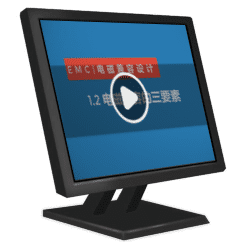- 易迪拓培训,专注于微波、射频、天线设计工程师的培养
FLOEMC使用手册
可以查看到帮助.但是依然不解决问题.
自带的帮助,e文的.
FLO/EMC Attribute Types
The attribute types used to define the modeling objects are:
Material - describing the electromagnetic properties of a material
Surface - surface finish (only needed if you intend to transfer the project later to FLOTHERM)
Transients - defining the functions describing time-dependent variables.
Outputs - selecting the variables to be calculated over a region.
Circuits - defining the electric circuits that wires belong to.
EM Sources - describing the field strength for an electromagnetic source.
Field Components - setting the electromagnetic field components at a monitor point.
For some modeling objects, such as fans, some attributes are attached as part of the geometry set-up using the object definition dialogs. But, for most attributes, you attach them as an independent action.
Attribute and Library Trees
Attributes are defined and stored independently from the modeling objects they describe, so that the same single attribute specification may be applied to multiple objects.
Attributes are stored in two main library directories displayed in the Library Manager.
From either of these two areas the attribute specifications can be copied (attached) to a modeling object by dragging from the store area and dropping on the modeling object in the project data tree or using attachment dialogs.
Project Attributes
The attributes known to the current project, that is, those attributes created in or copied to the project, can be seen when you expand the Project Attributes nodes. In the figure below, you can see the ambient and source attributes defined for this project
.
See "Creating Attributes"
Central Library
Expanding the Libraries node displays the central library folders used to transfer definitions across projects. The figure below shows the first few entries in the supplied FLOTHERM Material Library
See "Library Manager" for a full description of the Library panel.
3: Set Up an Emission Type Simulation
All the simulation settings (type of solution, frequency range of interest and maximum simulation duration) can be controlled from the Modeling dialog.
StepsDescription
1.Launch the Modeling Dialog
In the Project Manager, choose [Model/Modeling...] to launch the Modeling dialog. Note the different modeling options for the project. See "Notes On Types of Excitation" below.
2.Set the Type of Solution
In the Modeling dialog, set:
Type of Solution to Internal Source(s)
The frequency range of interest:
Minimum Frequency Range = 700 MHz
Maximum Frequency Range = 1600 MHz
For the total simulated time, i.e., the time after which the solver automatically stops, set:
Max. Simulation Duration = 100 ns and make sure that the Terminal Resid. Energy = 0
Click [OK] to exit the Modeling dialog.
Notes On Types of Excitation
FLO/EMC can run three different types of simulations:
External Source: An external source (plane wave) radiates on the model. The plane wave is usually used to simulate an Electromagnetic source that is very far away from the model. The polarization and the direction of propagation can be controlled from the modeling menu. This type of source is usually used for immunity problems.
Internal Source(s): A voltage source will be used to excite the model. The voltage source it is usually placed inside the model for emissions problems. However, there is no restriction on the position of the sources.
Different of Excitation Types can be used in conjunction with the Internal Source(s).
The Broad band type, excite the model using a time domain pulse. The frequency response to this type of impulse is going flat over the frequency range of interest. In other words, the Broad band pulse excites each single frequency in the frequency range of interest with the same amplitude.
The Direct excitation allows you to specify a custom transient waveform that FLO/EMC will use to excite the model.
The Indirect excitation runs the simulation using a Broad band pulse but at the end of the simulation, it will convolve the results using a user-defined transient.
For more information about Broad band, Direct excitation and Indirect excitation, please refer to "Transient Excitation for an Internal Source(s) Solution".
Coupling: One or more ports have to be specified inside the model. The S-parameters between those ports will then be calculated.
The frequency range of interest and the Max simulation duration have to be carefully selected because are related to the computational resources required to run the simulation. Please refer to the training manual and to the on-line help to have more detailed information.
On to 4: Introduction to the New Object Palette...
很多东西 说的很不清楚
恩,看它自带的帮助文档吧。
那多半还是你的安装方法不对,请参考dfmt版主的详细安装步骤
终于解决了安装问题,万幸啊
看看!多谢楼主!
在哪下载啊我很想看看
EMC电磁兼容设计培训套装,视频教程,让您系统学习EMC知识...
射频工程师养成培训教程套装,助您快速成为一名优秀射频工程师...
上一篇:Design considerations for space-based radar phased arrays
下一篇:求助:GJB151A中的CS114、115、116的测试原理是什么啊?

